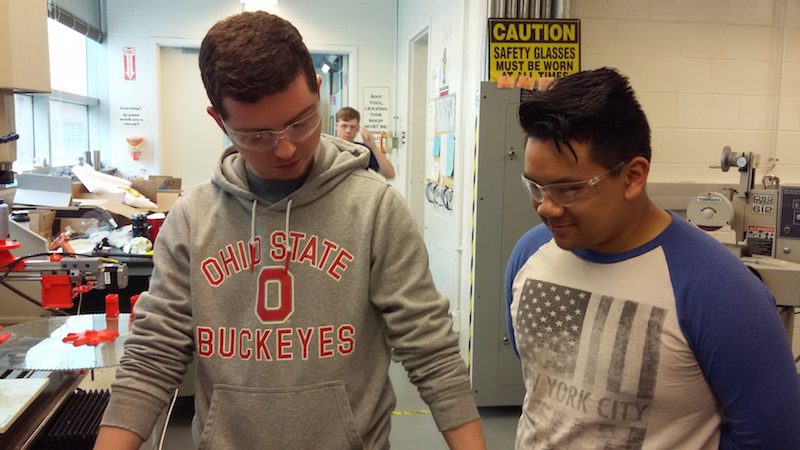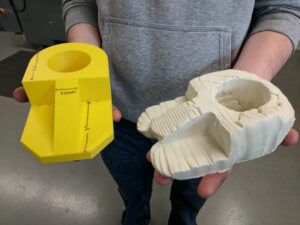NEWS & EVENTS
Ohio State Team Claims Top “LIFT Prize” In Next Wave of Digital Manufacturing Challenge

Students successfully programmed forming press as a robotic blacksmith
to shape clay into horseshoe and bracket
Contact:
Joe Steele
(313) 309-9131
jsteele@lift.technology
DETROIT – A team from The Ohio State University claimed the $25,000 top prize in phase one of the LIFT Prize in Robotic Blacksmithing, a challenge designed to encourage teams of college and high school students to innovate in manufacturing technology.
The LIFT Prize in Robotic Blacksmithing, or metamorphic manufacturing, was created by LIFT – Lightweight Innovations For Tomorrow, a Manufacturing USA Institute, and Ohio State’s Center for Design and Manufacturing Excellence to combine the ancient skills of the blacksmith with digital age robotics to create new material forming capabilities.
 In phase one of the LIFT Prize, teams were asked to program a machine to shape clay, or plastecine, into two predetermined shapes. Options included a goblet, a horseshoe and a bracket.
In phase one of the LIFT Prize, teams were asked to program a machine to shape clay, or plastecine, into two predetermined shapes. Options included a goblet, a horseshoe and a bracket.
The Ohio State team, “Team Honeybadger,” claimed first place from the judges after successfully adapting a CNC machine with custom software and a forming end affector to create a horseshoe and a bracket using small incremental deformation steps. This process can be adapted to the local on-demand forming of metallic components. The second and third place schools were Columbus, Ohio’s Metro High School and the University of Michigan. The teams will receive prizes of $25,000; $15,000 and; $7,500 respectively for their work in the contest.
“It was fun for us to work on a project that may someday fill a niche that nobody thought would exist,” said Brian Thurston, Team Honeybadger member and 4th Year Mechanical Engineering Undergraduate student at The Ohio State University, Class of 2017.
The work from each of the teams can be found here.
Through this competition, LIFT is promoting robotic blacksmithing as the next wave of digital manufacturing technology. It comes on the heels of the first two digital manufacturing revolutions: computer numeric control, in which cutting tools precisely remove metal to form complex shapes; and additive manufacturing and 3-D printers, which add layers of material by computer control to create complicated solid components. The robotic blacksmithing approach can use a wider range of materials and produce great material properties, and by reshaping, instead of cutting, material is not cut away and feedstock is readily available.
“It was a thrill to see the results of all of the students’ work,” said Ohio State Professor of Materials Science and Engineering Glenn Daehn, the competition’s technical director and leader of LIFT’s Agile and Low-Cost Processes Pillar. “Robotic Blacksmithing is the next wave of digital manufacturing and this competition is giving students the opportunity to innovate and pioneer its future.”
 While this first phase used soft plastecine to prove the concept of robotic blacksmithing, the concept can be applied to metals. Future phases of the competition will ask students to form shapes out of more challenging metals.
While this first phase used soft plastecine to prove the concept of robotic blacksmithing, the concept can be applied to metals. Future phases of the competition will ask students to form shapes out of more challenging metals.
LIFT, one of the founding Manufacturing USA institutes, and a part of the National Network of Manufacturing Innovation program, is a Detroit-based public-private partnership dedicated to developing and deploying advanced lightweight metal manufacturing technologies, and implementing education and training programs to better prepare the workforce today and in the future.
Read more about the technical aspects of Robotic Blacksmithing here.
ABOUT LIFT
LIFT, operated by the American Lightweight Materials Manufacturing Innovation Institute (ALMMII), is a
Detroit-based, public-private partnership committed to the development and deployment of advanced
lightweight metal manufacturing technologies, and implementing education and training initiatives to better prepare the workforce today and in the future. LIFT is one of the founding institutes of Manufacturing USA, and is funded in part by the Department of Defense with management through the Office of Naval Research.
Visit www.lift.technology or follow on Twitter @NewsFromLIFT to learn more.
ABOUT THE OHIO STATE UNIVERSITY
The Ohio State University’s main campus is America’s largest and most comprehensive, with more than
53,000 students, 17 colleges and 240 masters’, doctoral and professional degree programs and an annual
operating budget of more than $4 billion. Ohio State’s depth and excellence is complemented by a top-five academic medical center and a premier cancer center.
Ohio State consistently ranks as one of the nation’s top research institutions, with $703 million in spending last year in areas that are critical to Ohio’s ability to compete locally, nationally, and internationally. The university ranks second nationally in the amount of industry sponsored research it conducts. Ohio State has particular strength in areas such as global warming, cancer, infectious disease, advanced materials, and ag-bio products that feed and fuel the world.